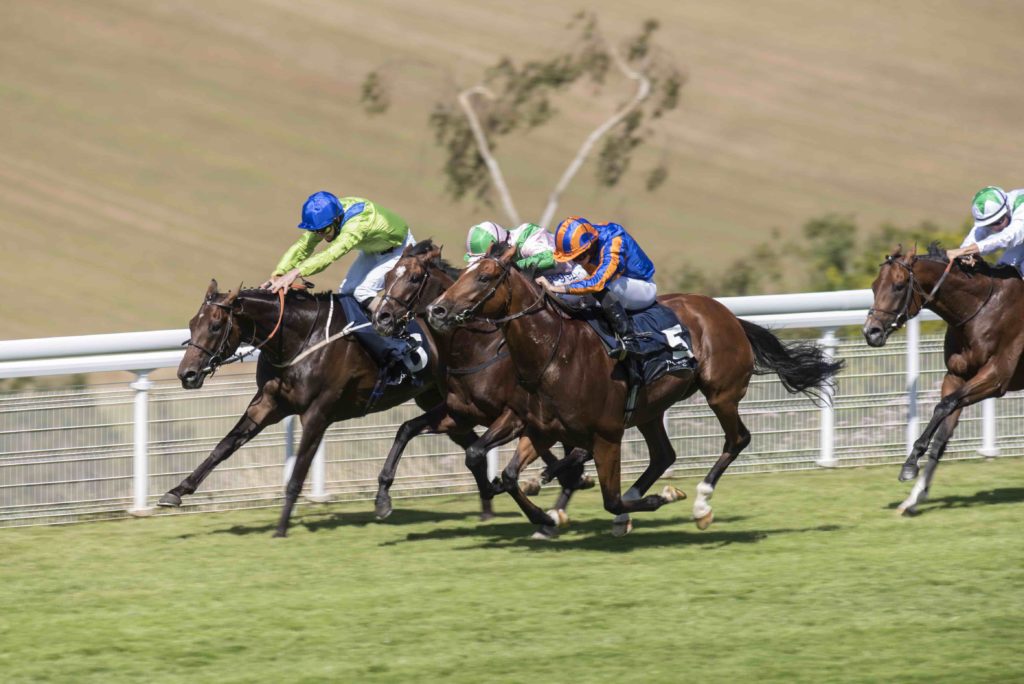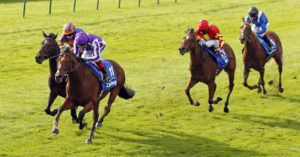Switch the years yet the scene remains the same – a crowd gathers as a Newsells Park Stud yearling walks into the ring destined to become the subject of intense bidding, so much so that it smashes through the million guinea mark and perhaps beyond into the three million region.
Yearlings out of Shastye have been one of the great attractions of the Tattersalls October Sale for the best part of a decade. In a business fraught with unpredictability, the Danehill mare is an animal that goes against the grain. Aided by an alliance with Galileo, success has never been far away, whether it be on the track or in the sale ring. It’s another example of the productive nature of the Galileo – Danehill cross, and indeed in this instance, the pair invariably complement each other to a high degree, with the result often a yearling in possession of the attributes to fire up the market before developing into a fine racehorse.
Since 2013, Galileo yearlings out of Shastye have realised a total of 12,820,000gns at the Tattersalls October Sale – for an average of 2,564,000gns. Six of her seven runners are winners and include four Group winners to Galileo in Japan, Mogul, Secret Gesture and Sir Isaac Newton, and another stakes winner to Medicean in Maurus, a Listed winner in Australia.
Naturally when Galileo is in play, market interest is fuelled by Coolmore and their partners. Overall, they account for 11,700,000gns of the mare’s Tattersalls’ sales and with good cause, given that in return they have come away with a Group 3 winner in Sir Isaac Newton (bought for 3,600,000gns in 2013), champion Japan (bought for 1,300,000gns in 2017) and Mogul, a 3,400,000gns purchase in 2018 and now a two-time Group 1 winner by virtue of his win in Sunday’s Hong Kong Vase at Sha Tin.
Understandably, the outfit was keen to return to the well when Shastye’s latest yearling, a filly, came under the hammer in October, with MV Magnier going to 3,400,000gns to outbid David Redvers and Oliver St. Lawrence.
“In a business fraught with unpredictability, Shastye is an animal that goes against the grain”
Aidan O’Brien is in a fair position to understand Shastye’s stock, having trained three of her foals to win ten stakes races, but there is a sense that Mogul, after spending the winter as one of the leading fancies for the Derby, is only now starting to justify expectations.
A strong, barrel of a horse, Mogul evidently requires plenty of racing to run into fitness. With that in mind, the disruptive start to the season would not have played to his strengths. After running underwhelming races in the King Edward VII Stakes and Derby, he finally broke through for the season in the Gordon Stakes at Goodwood. However, he was all out to defeat Highland Chief that day and was again underwhelming when well beaten in the Great Voltigeur Stakes.
Then it all clicked. Sent to Longchamp for the rescheduled Grand Prix de Paris, Mogul showed a smart turn of foot to scythe up the rail and run down his pacemaker to win easily from In Swoop. It was a fine performance that saw him become the second official Group 1 winner out of Shastye following Japan, who had triumphed in the same race the previous summer. An earlier daughter of Shastye, Group 2 winner Secret Gesture, also finished first past the post in the 2015 Grade 1 Beverly D. Stakes at Arlington Park only to lose the race in the stewards’ room.
With placings in the Epsom Oaks, Preis Der Diana, Yorkshire Oaks and Prix Jean Romanet to go with that Beverly D. demotion, Secret Gesture must go down as one of the most talented runners not to win a Group 1. Ironically, she is also the cheapest of the seven yearlings out of Shastye to pass through Tattersalls, having been bought back by Newsells Park for 230,000gns in 2011.
Newsells’ connection to Shastye dates back to her purchase in 2005 through John Warren for 625,000gns.

Mogul (orange and blue) is out of Newsells Park Stud’s Shastye – Photo: George Selwyn
Then a four-year-old, Shastye offered the potent combination of talent and pedigree. Trained by John Gosden on behalf of her breeder Skara Glen Stables, she won twice over 12-13 furlongs and gained black-type when going down narrowly to Songlark in the Listed Pontefract Castle Stakes.
Shastye belied her 16/1 odds that day and although beaten, there must have been a sense of job done in gaining black type for a filly supported by such a big pedigree.
By Danehill, she was a half-sister to two of Jean-Luc Lagardere’s best horses in Sagamix, the 1998 Arc winner, and Sagacity, winner of the 2000 Criterium de Saint-Cloud. Another half-sibling, Sage Et Jolie, won the 1999 Group 2 Prix de Malleret before foaling Sageburg, who won the Prix d’Ispahan in the aftermath of the Aga Khan’s acquisition of Lagardere’s stock. The absorption of Saganeca’s family also reaped further rewards for the Aga Khan in the form of Sagawara, the 2012 Prix Saint Alary winner who was out of an unplaced half-sister in Sagalina.
The source of this fruitful line is the Sagace mare Saganeca. A cheap $30,000 yearling purchase by Horse France, Saganeca was saddled by Antonio Spanu to beat the subsequent famed producers Brooklyn’s Dance and Wajd in the 1991 Prix de Royallieu. She later became Italy’s champion older mare of 1992 by virtue of a runner-up placing to Mashaallah in the Gran Premio di Milano and was also fifth to Subotica in that year’s Arc.
One of only six stakes winners sired by Arc winner Sagace, Saganeca was also the best of five foals out of the winning Hagley mare Haglette, herself a half-sister to French juvenile Group 2 winner Round Top. There is a lack of notable achievers in her immediate generations, but she boasted a strong back pedigree as a great-granddaughter of the French champion La Mirambule, dam of the 1964 King George winner Nasram II and 1962 Irish Derby winner Tambourine II.
“Shastye offered the potent combination of talent and pedigree”
The less than fashionable immediate reaches of her pedigree probably explains how Lagardere managed to secure Saganeca for a relatively inexpensive $165,000 through Eric Puerai at the 1994 Keeneland January Sale. In keeping with Lagardere’s primary policy of the time, Saganeca became a regular visitor to his Classic-winning miler Linamix – and with great results when she clicked with that stallion to produce Sagamix and Sage Et Jolie.
Thus, Saganeca proceeded to make her own pedigree – Sagamix was her first foal, Sage Et Jolie her second and Sagacity, by Highest Honor, her fourth – and so when the mare next came up for sale in foal to Storm Cat at Keeneland in 2003, she commanded $2 million from John Magnier. She went on to produce another seven foals for her new owners, mainly to Sadler’s Wells and his sons, but never came close to replicating her success for Lagardere as the dam of only two other winners.
Saganeca did, however, leave behind seven daughters, five of whom are now stakes producers. The list includes Sage Et Jolie, whose son Sageburg is now a successful sire under both codes, Sagalina (the dam of Sagawara) and Piping, a daughter of Montjeu bred by the Coolmore-affiliated Tower Bloodstock who has produced the talented stayer The Grand Visir.
However, Shastye rises above them all as an emerging blue hen in her own right, especially as her record of five stakes winners includes two desirable stallion prospects in Japan and Mogul.
Judging on Sunday’s clear cut Sha Tin success, Mogul in particular appears to be on an upward trajectory, making him a likely candidate to become a leading older horse of 2021.



